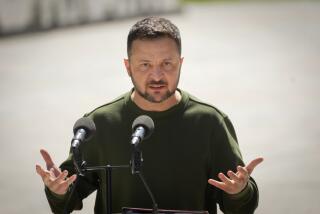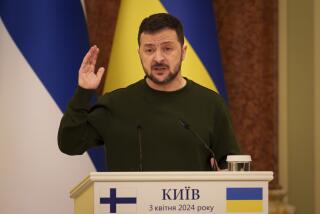Poles’ Naming of Ex-Spy to Top Post Embarrasses U.S. : Espionage: Warsaw’s new intelligence chief was given life in prison after a Los Angeles trial. He was released in 1985 as part of a Cold War exchange.
WASHINGTON — In an embarrassment for the United States, Poland’s non-Communist government has named one of the Cold War era’s most successful Soviet Bloc spies as head of its civilian intelligence service.
Marian Zacharski, 43, was sentenced to life imprisonment in the United States in 1981 for obtaining secret information on the U.S.-made B-1 bomber, the F-15 fighter and radar systems used in Patriot air-defense missiles, then passing the information to the East Bloc.
He was sent back to Poland in 1985 as part of an exchange of four East European spies for 25 Western intelligence agents who themselves had been convicted and imprisoned in East Germany and Poland. He received limited clemency from then-President Ronald Reagan.
But Justice Department officials said that, under terms of the exchange, if Zacharski was to return to the United States--even in his official capacity as Poland’s intelligence chief--he would be subject to arrest and reimprisonment here. “We haven’t changed our position,” a department spokesman said.
The irony does not stop there. Since the late 1980s, when Warsaw shucked off its Communist mantle, Zacharski has become one of Poland’s leading businessmen--a director of its most profitable retailing chain, the Pewex import merchandise shops.
His years spent in the United States apparently were a learning experience for both sides. His performance in recruiting a disgruntled defense worker as an agent is still being studied at the FBI Academy. And he, in turn, learned American business techniques.
Even so, his appointment may prove awkward for both governments. Supported by the United States, Warsaw recently has joined the North Atlantic Treaty Organization’s “Partnership for Peace” program, designed to groom former East Bloc countries for eventual membership in NATO.
And Poland has been campaigning hard to become a full-fledged member of the Atlantic military alliance now, rather than after an apprenticeship. “This isn’t the kind of thing that they’re likely to put on their NATO application form,” one U.S. official said.
Washington apparently was taken by surprise when the appointment was disclosed. U.S. officials said the State Department had not known in advance that Zacharski would be named to the post, and as of late Tuesday, the Clinton Administration had not decided how to react.
U.S. intelligence officials apparently are urging that Washington not protest strongly, arguing they can work with someone who was in the intelligence business. Still, “it’s not the greatest thing that can happen,” a U.S. diplomat said.
Zacharski was tried and convicted in federal district court in Los Angeles after having successfully recruited William Holden Bell, a radar system expert at Hughes Aircraft Co. in El Segundo, to provide him with copies of documents in exchange for cash. Bell served as the key prosecution witness in Zacharski’s trial, after pleading guilty to one count of passing secret documents to foreign agents, in exchange for a lighter sentence.
One reason authorities were able to prosecute Zacharski was that, unlike many spies who arrive in the United States protected by diplomatic immunity, the Pole was working as a civilian as West Coast representative of the Polish-American Machinery Corp.
Zacharski’s appointment was signed Friday by the chief of the State Protection Office, a leading Warsaw daily newspaper reported. News of his appointment was broadcast Tuesday on Polish TV.
According to news service reports, at least some Polish security officials and members of Parliament voiced surprise and criticism over the promotion of a man who served the former Soviet-controlled intelligence agency, but there was no official reaction to the move.
More to Read
Sign up for Essential California
The most important California stories and recommendations in your inbox every morning.
You may occasionally receive promotional content from the Los Angeles Times.








